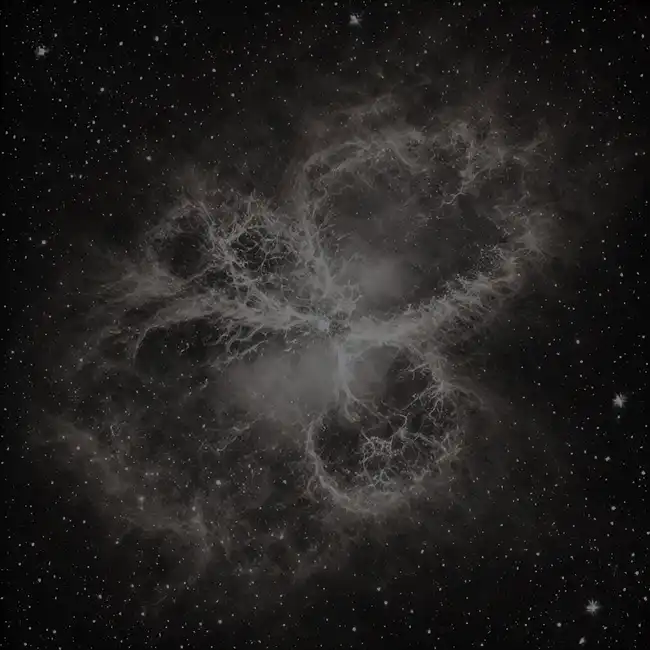Messier 1, commonly known as the Crab Nebula, is a supernova remnant located in the constellation Taurus. It is one of the most studied objects in the night sky due to its unique structure and historical significance. The Crab Nebula is the result of a supernova explosion that was observed by Chinese and Arab astronomers in 1054 AD. The remnant is a complex, expanding cloud of gas and dust, with intricate filaments surrounding a pulsar, the Crab Pulsar, at its center. This pulsar is a highly magnetized, rotating neutron star that emits beams of radiation and is one of the strongest known sources of gamma rays.
The nebula spans approximately 11 light-years across and continues to expand at a rate of about 1,500 kilometers per second. Its distinct shape and vivid colors, which are visible in long-exposure images, make it a fascinating target for both amateur and professional astronomers.
Magnitude
The Crab Nebula has an apparent magnitude of about 8.4, which makes it just beyond the visibility of the naked eye. However, it is easily visible through small telescopes, and even binoculars can reveal it under good conditions. The brightness of the nebula is relatively stable, but its intricate details become more apparent with the use of larger telescopes and longer exposure photography.

Prominent Season
Messier 1 is best observed in the late autumn and winter months, particularly from November to February. During these months, Taurus is high in the night sky, making the Crab Nebula easier to locate and view. It is visible in both the Northern and Southern Hemispheres, though it is better placed for observation from northern latitudes.
Constellation and Location
Messier 1 is located in the constellation Taurus, which is easily identifiable by its two prominent stars, Aldebaran and the Hyades cluster, as well as the more famous Pleiades cluster. The Crab Nebula is situated near the "horns" of the bull, about 1 degree northwest of the star Zeta Tauri.
How to Find Messier 1
To locate Messier 1, start by finding the constellation Taurus. Identify the bright star Aldebaran, which marks the eye of the bull. From there, trace the line towards the stars forming the bull's horns. Zeta Tauri, the tip of the southern horn, is your key marker. The Crab Nebula lies just northwest of Zeta Tauri.
Using a telescope with a low to medium magnification, center Zeta Tauri in your field of view. Then, slowly move your telescope slightly northwest, and you should see a faint, fuzzy patch—this is Messier 1. While the nebula's full glory requires a larger telescope or astrophotography to reveal, the smudge visible through smaller telescopes is still a rewarding sight, knowing its rich history and significance.

History
The Crab Nebula's history is deeply intertwined with human observation of the cosmos. The supernova that created it was visible during the day for 23 days and was recorded by Chinese astronomers in 1054 AD, who described it as a "guest star." Arab astronomers also noted its appearance. Remarkably, it was bright enough to be visible during the day and was visible to the naked eye for about two years before fading.
In 1731, British astronomer John Bevis discovered the nebula itself, marking it as an astronomical object of interest. Later, in 1758, Charles Messier independently found the nebula while searching for comets. Mistaking it for a potential comet, Messier cataloged it as the first object in his famous Messier Catalog, giving it the designation M1. This catalog eventually became a valuable resource for astronomers identifying "fuzzy" objects that could be mistaken for comets.
The connection between the historical supernova and the Crab Nebula was not made until the 20th century, when it was understood that the nebula was the remnant of the 1054 supernova. Subsequent studies, particularly with radio and X-ray telescopes, revealed the presence of the Crab Pulsar at its center, further cementing its status as a crucial astronomical object for studying supernova remnants, neutron stars, and the dynamics of expanding gases in space.
Conclusion
Messier 1, the Crab Nebula, is a celestial wonder that offers a glimpse into the life cycle of stars and the history of our observations of the universe. Whether viewed through a telescope or studied in detail with modern astronomical instruments, the Crab Nebula remains a fascinating subject for both amateur stargazers and professional astronomers alike.
